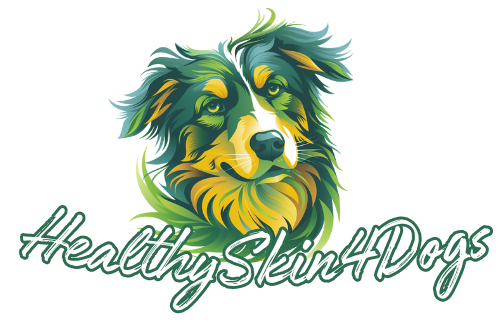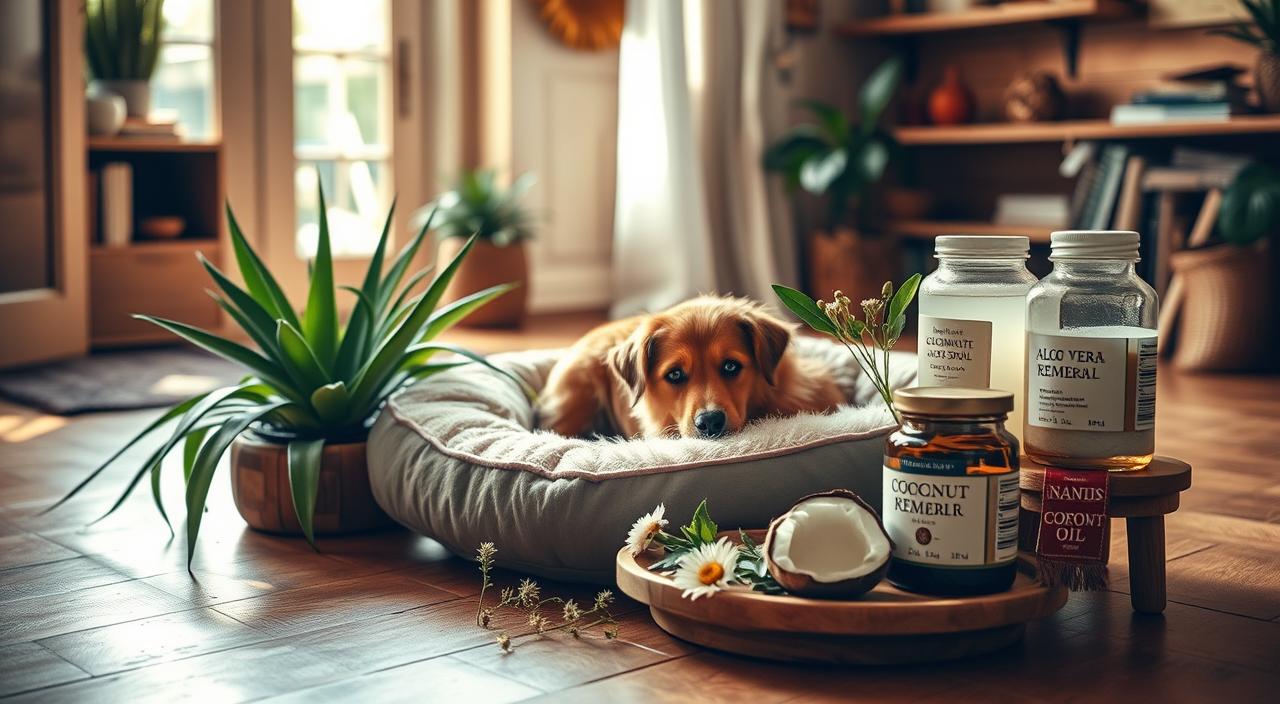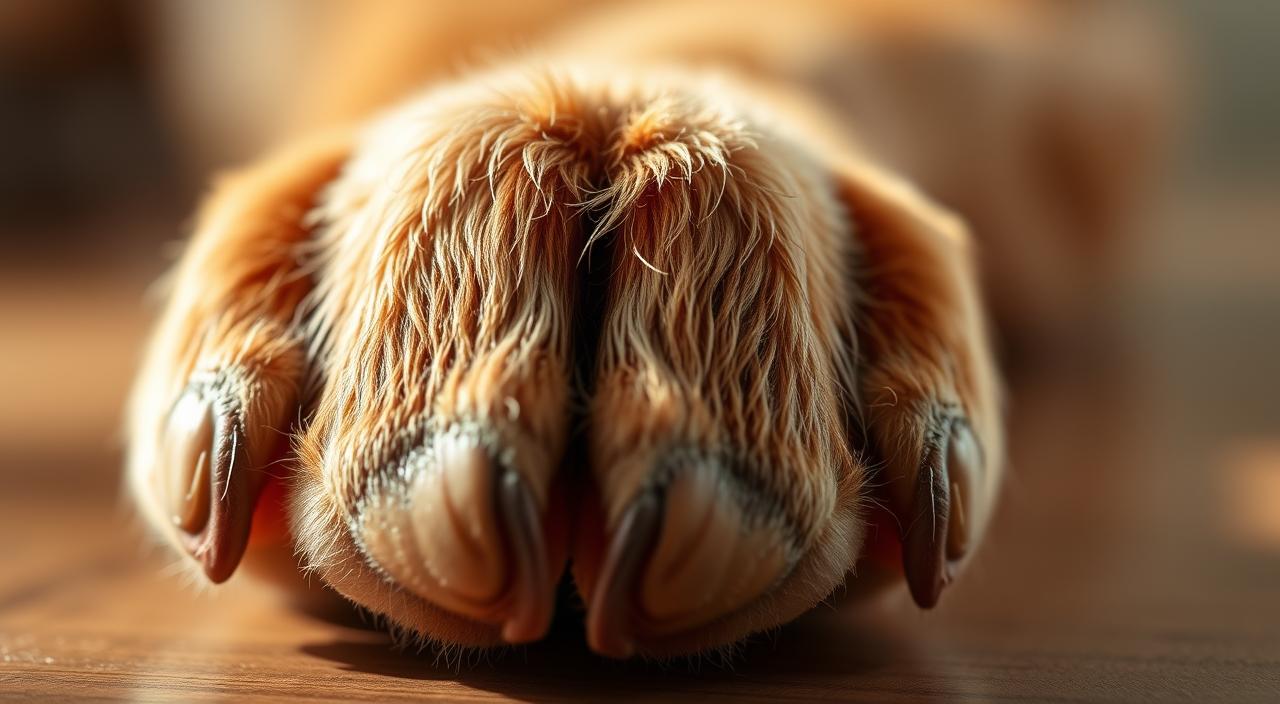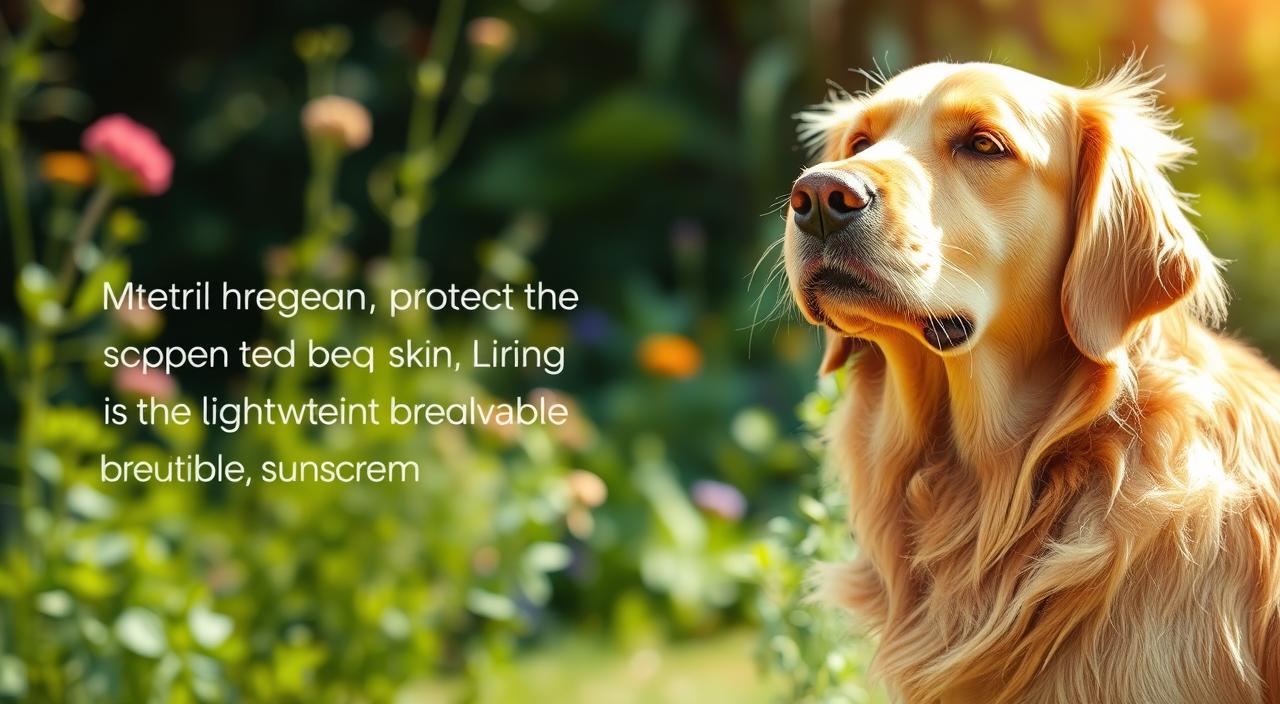You likely feel anxious when you see a bright, raw patch on your pet’s coat — dog hot spots home remedies can help you act fast and reduce pain. These fast-moving lesions, often called moist dermatitis, start small and can ooze, crust, or grow within hours if left alone.
We outline a calm, practical plan to dry the area, protect nearby skin, and stop the itch-lick-scratch cycle so healing can begin. The guide favors gentle cleaning, safe antiseptics, and simple barriers like a cone to prevent further chewing.
Thick-coated and water-loving breeds face higher risk, especially in humid weather, and owners should watch for heat, swelling, pus, or a foul smell — signs that require veterinary care. With prompt, steady steps many spots improve quickly, and we explain what to do and when to seek professional medications or treatment.
Key Takeaways
- Hot spots are painful, fast-spreading skin lesions that need prompt care.
- Core goals: dry the spot, protect adjacent skin, and stop licking.
- Gentle cleaning and non-irritating antiseptics are first-line at-home steps.
- Use a cone or barrier to break the itch-lick cycle while the area heals.
- Seek vet care if the lesion worsens, smells, oozes pus, or spreads over the body.
What hot spots look like and why they spread fast
A small irritated spot can turn into a wide, painful lesion in hours if it stays moist and unattended. Early recognition helps owners act before the area grows or becomes infected.
Common locations and telltale signs
These red, moist patches often appear cherry red and raw, sometimes with clear or yellowish discharge that crusts as it dries. Hair loss and a distinct red border around the spot are frequent early signs.
Owners usually find these lesions on the face, neck, chest, belly, legs, tail or paws—basically anywhere dog can easily reach. The skin around the lesion may be warm, painful, and surrounded by matted fur.
How licking, chewing, and moisture fuel the cycle
Moisture trapped in matted fur creates the ideal environment for bacteria to multiply. Even an hour of chewing or licking adds trauma and wetness that makes a small spot expand quickly.
The area can ooze fluid that keeps the patch damp and slows healing. Owners may notice restlessness or obsessive licking—clear signs the spot is painful and needs attention.
- Warm, inflamed patch with matted fur and hair loss.
- Common on head, neck, chest, hips, limbs and paws.
- Oozing or crusting discharge; foul smell can signal infections.
Early trimming and gentle cleaning reduce moisture and limit bacterial overgrowth. While many hot spots respond to prompt care, rapid enlargement, pus or odor are red flags for veterinary evaluation.
Quick safety notes before you start home care
A quick safety check helps decide if at‑home care is appropriate or if veterinary attention is needed right away.
Home care is reasonable for a small early hot spot when the dog is bright, eating, and not in obvious pain. If the lesion is limited and the animal tolerates gentle handling, carefully trimming and cleaning can help.
When to see a vet
Seek veterinary care if the spot shows pus, a foul odor, spreading or deepening redness, or active bleeding. Also call a clinic if the dog may be in significant pain or resists being touched near the skin.
- If no improvement within 24–48 hours of consistent care, a vet evaluation helps rule out infections that need prescription medications.
- Many skin conditions mimic a hot spot — fungal infections, parasites, or allergic dermatitis require different treatment.
- Recurring lesions often point to an underlying cause such as allergies, fleas, or hormonal issues; your vet can investigate.
- Do not start or stop prescription meds without guidance; improper use can mask signs and delay correct diagnosis.
- Keep brief daily notes on size, moisture, smell, and pain — these details help the clinic triage quickly.
Dog hot spots home remedies: a simple step-by-step plan
A calm, practical routine helps the injured skin dry and heal while limiting bacteria and pain. Follow clear actions so the lesion can move from moist to dry without added trauma.
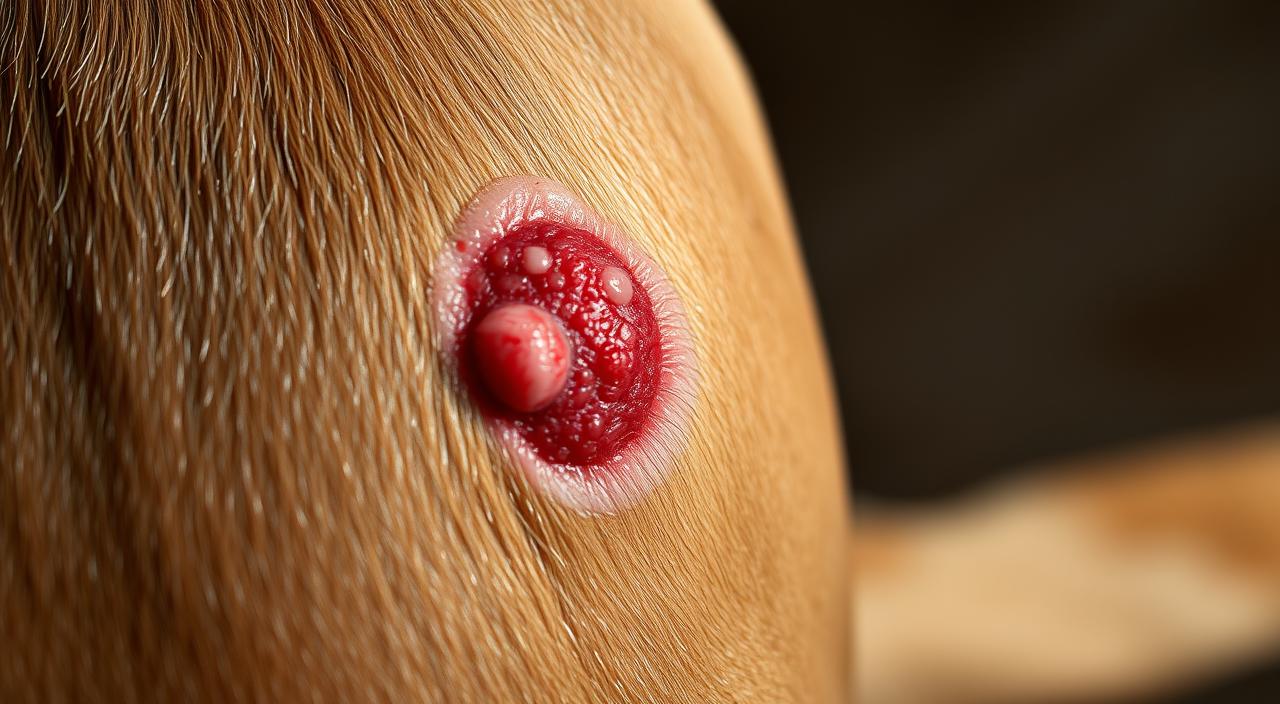
Quick step sequence
- Trim or shave fur several centimeters beyond the edge so the area can breathe and dry; mats trap moisture and bacteria.
- Rinse the clean area with cool water or a dilute chlorhexidine wash made for pets, then gently pat dry with a fresh towel—no dampness left behind.
- Apply a cool compress for a few minutes to ease pain, then remove it and let the spot stay exposed to air.
- Fit an elizabethan collar to stop dog licking and biting until the skin is less moist and itchy.
Practical tips
- Clean once to twice a day early on; avoid over‑scrubbing.
- Use separate towels each session and wash hands before and after handling the area.
- If trimming at home is unsafe, ask a vet or groomer to clip around the lesion.
| Action | Frequency | Purpose |
|---|---|---|
| Trim/shave fur | Once at start | Allow airflow; reduce trapped moisture |
| Clean with water/chlorhexidine | 1–2 times per day | Remove discharge and lower bacteria |
| Cool compress & collar | 2–4 times per day / continuous use | Soothe pain; prevent dog from re-wetting the spot |
Natural soothers and what to avoid on open, moist lesions
Natural, gentle soothers can calm inflammation and speed recovery when the lesion is moist but not deeply infected. The priority is to dry and protect the skin barrier while limiting bacteria and further irritation.
Herbal rinses and simple compresses
Calendula is a well-known herbal soother that reduces itch and supports tissue repair when applied after the area is cleaned and patted dry. Use a dilute calendula gel or cream sparingly on the spot.
HyperCal rinses (hypericum plus calendula) diluted in warm water make a gentle rinse to ease discomfort; always dry the area after use to avoid trapping moisture. Black tea compresses can help—tannins mildly dry the surface and offer light antimicrobial support as the lesion moves toward scabbing.
What to skip and why
- Avoid hydrogen peroxide: it damages healthy tissue and delays healing.
- Do not use Neosporin or similar human antibiotic ointments regularly—these are not formulated for dogs and can cause reactions.
- Skip heavy oils or butters on a wet lesion; they seal in water and feed bacteria instead of drying the spot.
Apple cider vinegar, dilution, and testing
Apple cider vinegar can reduce itching but often stings on raw, weeping skin. If used, dilute with water (commonly 1:1) and test a tiny area first. Stop immediately if the animal shows pain.
| Soother | When to use | Why |
|---|---|---|
| Calendula | After cleaning and drying | Calms inflammation; supports repair |
| Black tea compress | For wet, oozing lesions | Tannins help dry and mildly reduce bacteria |
| Apple cider vinegar (diluted) | Only on non-raw skin, brief test | May reduce itch; can sting open wounds |
Use alcohol-free preparations when possible and add one soother at a time to spot-test for sensitivity on dog skin. If there are signs of infection—pus, odor, or rapid worsening—pause home care and contact a vet for possible medications and further treatment.
Target the underlying cause so hot spots don’t come back
Preventing future lesions means tracing the trigger and changing routines that let irritation return. Treating the visible patch helps now, but lasting improvement follows when owners remove what repeatedly harms the skin.
Common triggers and simple fixes
- Parasites: fleas or ticks can cause dermatitis from bites—use year‑round flea tick prevention.
- Allergies: food or environmental allergies lead to inflammation that invites licking and a wet spot.
- Moisture and mats: dense coats trap water; regular grooming and thorough drying cut risk.
- Behavior: boredom or stress drives repetitive licking—add exercise and puzzle toys to reduce this habit.
| Cause | Action | Why it helps |
|---|---|---|
| Parasites | Monthly prevention | Stops bites that trigger dermatitis |
| Coat mats | Trim and comb regularly | Allows airflow; prevents trapped moisture |
| Boredom licking | Enrichment & exercise | Reduces repetitive behavior that reopens a spot |
Keep a simple log of flare-ups, weather, and diet. If lesions recur despite these steps, consult a vet to investigate the underlying cause and refine a prevention plan.
At-home supplies checklist for clean, dry healing
Preparedness reduces delays: the right tools let you clean, dry, and protect the affected area with calm efficiency.
Keep a simple kit ready so steps are quick and consistent. Start with clippers or guarded scissors to shorten fur and hair several centimeters beyond the edge. This helps airflow and faster drying.
- Chlorhexidine or a gentle pet antiseptic to cleanse the spot without harsh irritation.
- Soft, lint‑free cloths and multiple clean towels — use a fresh towel each session and launder after use.
- An Elizabethan collar (cone) plus a spare in case the first fit is uncomfortable or breaks.
- Small spray bottle for water or diluted rinse solutions; label a second bottle for any herbal soother.
- Disposable gloves to protect hands and lower cross‑contamination risk.
- Cool‑compress materials and a low‑heat hair dryer to finish drying from a safe distance.
Arrange supplies in one basket so routines stay steady. Make sure bedding is washable and dry; change it often so the skin and surrounding fur stay clean.
| Supply | Purpose | Quick tip |
|---|---|---|
| Pet clippers / scissors | Shorten fur to improve airflow | Use a guard; clip beyond visible edge |
| Chlorhexidine wash | Clean and reduce bacteria | Dilute as directed; pat dry after using |
| Clean towels & cloths | Dry and remove discharge | One towel per session; wash promptly |
| Elizabethan collar | Prevent licking and re‑wetting | Keep a spare for quick replacement |
| Spray bottle & gloves | Safe rinsing and hygiene | Label bottles; change gloves between tasks |
Recovery timeline and signs you’re on the right track
Recovery follows predictable steps when prompt care starts quickly. Owners can watch simple changes each day to know whether the spot is improving or needs a clinic visit.
Typical drying, scab formation, and hair regrowth milestones
With steady care the area often moves from wet to tacky within a few days. By about one week many lesions are noticeably drier and begin to form a scab.
Hair usually begins to regrow around week two, though full coat recovery can take longer. Reduced redness, lower heat at the site, and shrinking edges are good signs the routine is working.
When spreading, odor, or pus means it’s time for the vet
Contact a vet promptly if the borders spread, thick yellow or green discharge appears, or a foul smell develops. Increasing pain, lethargy, feverish behavior, or rapid hair loss suggest complications.
- Keep the elizabethan collar on during early healing to stop dog licking that can restart the cycle.
- Take daily photos to track size and moisture — subtle improvements are easier to spot over time.
- Avoid picking scabs; protect the skin and ease back on rinsing once the surface is clearly dry.
| Milestone | Typical time | What to watch for |
|---|---|---|
| Drying to tacky | 2–4 days | Less oozing; tacky surface |
| Scab formation | About 1 week | Reduced redness; shrinking edges |
| Early hair regrowth | 2 weeks+ | Short hairs at lesion margin |
Prevention that works: grooming, parasites, and daily habits
A few minutes of focused grooming after outdoor time often prevents larger problems later. Regular brushing removes loose hair and stops mats that trap moisture and bacteria. Make a predictable routine: quick brush daily, fuller grooming once every 2–6 weeks depending on coat type.
Keep coats clean, thoroughly dried, and free of mats
After baths or swims, towel-dry and use a low-heat dryer at a safe distance. Make sure the undercoat is dry—dense fur holds water and invites dermatitis. Partner with a groomer for de-matting if you can’t reach undercoats without tugging the skin.
Flea and tick control, plus drying after swims or baths
Use year-round flea tick prevention to stop bite-triggered itching that can lead to a new spot. Check neck ruffs, hips, and tail base after hikes and humid days for early signs so issues are caught fast.
Omega-3s, exercise, and mental stimulation to reduce itching and boredom
Adding EPA/DHA fish oil supports the skin barrier and lowers baseline inflammation. Daily exercise and enrichment reduce boredom-driven licking that reopens lesions. Launder bedding frequently and keep sleeping areas dry to limit bacterial growth.
| Action | Why it helps | Frequency |
|---|---|---|
| Brushing & spot checks | Prevents mats; finds small spots early | Daily |
| Drying after water | Reduces moisture that feeds bacteria | Each water exposure |
| Flea/tick prevention | Stops bites that trigger dermatitis | Year-round per product |
| Omega-3 supplementation | Supports skin health and reduces itch | Daily per vet advice |
Breed and season factors that raise the risk
Some dogs carry higher risk of rapid lesion growth because their coat type and habits trap moisture next to the skin. Thick or double coats—think Golden Retrievers, German Shepherds, Rottweilers, Saint Bernards, and Labradors—hold water and heat, so minor irritation can become a larger problem quickly.

Why thick-coated and water-loving breeds need extra vigilance
Warm, humid seasons raise flare rates: sweat and humidity soften the skin and increase friction. Water-loving animals that swim or splash need prompt towel and air drying to stop bacteria from multiplying in damp fur.
- Check heavy ruffs, tail feathers, and dense undercoats often—spots can hide there.
- Adapt grooming to season and activity: more frequent trimming in summer or after swims.
- Keep a quick drying station by the door—towels, a low-heat dryer, and a spare collar speed care after outings.
| Risk factor | Action | Benefit |
|---|---|---|
| Thick/double coat | Trim and inspect weekly | Reduces trapped moisture near dog skin |
| Frequent swimming | Towel and air‑dry after water | Limits bacteria growth on fur and body |
| Warm, humid season | Increase checks and flea plan | Prevents recurring spots and infection |
Learning each animal’s recurring hot zones—neck, hips, tail base—helps owners act earlier and lower the chance of multiple spots forming at once.
Conclusion
A steady, simple plan—trim, cleanse, dry, and protect—usually sends a wet hot spot toward recovery in a short time.
Act early: allow airflow, rinse with cool water or dilute antiseptic, pat dry, use a cool compress, and fit an Elizabethan collar to stop licking. These consistent steps often improve the lesion within days without medications.
If the spot spreads, smells, oozes pus, or shows no progress in 24–48 hours, contact a vet for evaluation and targeted support for infections.
Prevention matters: regular grooming, thorough drying after water, flea and flea tick control, and reduced boredom through exercise lower recurrence. Discuss omega‑3s and nutrition with the care team to support dog skin health.
Keep supplies organized and follow a short daily checklist—trim, rinse, pat dry, compress, cone—until the spot is dry and quiet. For broader context on common skin conditions, see common skin conditions.
